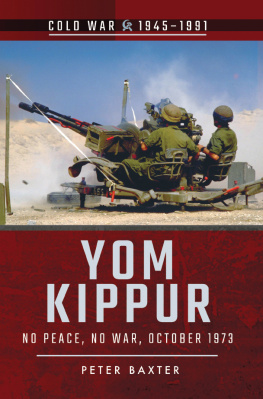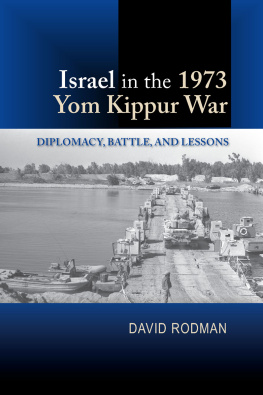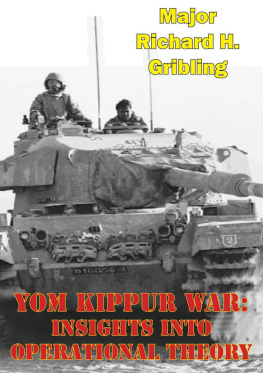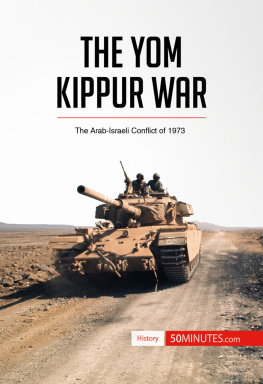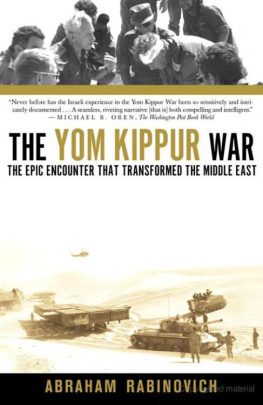
At the Decisive Point in the Sinai
FOREIGN MILITARY STUDIES
History is replete with examples of notable military campaigns and exceptional military leaders and theorists. Military professionals and students of the art and science of war cannot afford to ignore these sources of knowledge or limit their studies to the history of the US armed forces. This series features original works, translations, and reprints of classics outside the American canon that promote a deeper understanding of international military theory and practice.
The Institute for Advanced Military Thinking (IAMT) was formed by retired senior officers of the Israel Defense Forces to serve as a bridge between the theories and policies of the academic world and the doctrine, training, and other preparations required for field operations. The IAMT applies this approach across the full spectrum of future land warfare by:
initiating and supporting joint discussions regarding the historical lessons offered by land warfare in the Middle East;
encouraging innovative thinking and open debate about current critical defense issues;
supporting decision makers as they prepare for future challenges.
SERIES EDITORS: Roger Cirillo and Gideon Avidor
An AUSA Book
AT THE DECISIVE POINT IN THE SINAI
Generalship in the Yom Kippur War
General Jacob Even, IDF (Ret.),
and
Colonel Simcha B. Maoz, IDF (Ret.)
Translated by Simcha B. Maoz and Moshe Tlamim
Originally published in Hebrew by Modan Publishing House, Ltd., Maarachot (IDF Publishers).
Copyright 2017 by The University Press of Kentucky
Scholarly publisher for the Commonwealth,
serving Bellarmine University, Berea College, Centre College of Kentucky, Eastern Kentucky University, The Filson Historical Society, Georgetown College, Kentucky Historical Society, Kentucky State University, Morehead State University, Murray State University, Northern Kentucky University, Transylvania University, University of Kentucky, University of Louisville, and Western Kentucky University.
All rights reserved.
Editorial and Sales Offices: The University Press of Kentucky
663 South Limestone Street, Lexington, Kentucky 40508-4008
www.kentuckypress.com
Cataloging-in-Publication data is available from the Library of Congress.
ISBN 978-0-8131-6955-2 (hardcover : alk. paper)
ISBN 978-0-8131-6957-6 (epub)
ISBN 978-0-8131-6956-9 (pdf)
This book is printed on acid-free paper meeting the requirements of the American National Standard for Permanence in Paper for Printed Library Materials.
Manufactured in the United States of America.
| Member of the Association of
American University Presses |
Contents
by Major General Gershon Hacohen
Foreword
Unlike other works on generalship at the strategic level, such as Eliot A. Cohens The Supreme Command, this book focuses on generalship at the senior field command level, that is, the division commander and his team. It is the story of generalship as it was revealed on the battlefield in Major General Ariel Sharons 143rd Division in the Yom Kippur War.
The authors, Major General (Res.) Jacob Even and Colonel (Res.) Simcha Maoz relate the heroic events that they played a major role in. General Even was the deputy commander of the 143rd Division and Colonel Maoz his assistant. Their involvement in the war is the source of the books authority, but the story is not about their personal experiences; instead, it describes the war from the view of senior officers who were partners in the generalship of their commander, Major General Ariel Sharon.
I have purposely chosen the word story rather than research because a good story is more powerful than meticulously detailed historical research that describes precisely what happened without delving into the depth of the story or teaching what could have happened. Cognizant of their duty to future generations of commanders, the authors wish to present their concept of the Yom Kippur War in order to instruct a younger generation of senior field commanders in the essence of their responsibility and the degree to which a military operations fortune rests on their shoulders.
As a matter of principle, a division commander in all armies carries the rank of major general. It is not only his formal position in the military hierarchy that determines this rank but also the unique function he fulfills as one who is required to stand at the point of interface between the tactical dimensions of war and its operational and strategic dimensions. By dint of his professional wisdom, prestige, and leadership authority, which also determine the specific gravity of his opinions and recommendations for the political level, a division commander serves as an intermediary point between the view of war as a mosaic of microevents and the broader perspective of it as a macroevent.
It is generally considered, and occasionally even taught, that the supreme strategic level issues orders outlining what to do and leaves to the operational level the responsibility of deciding how to do it. But a close familiarity with the development of the war teaches how often the exact opposite happens. A person who knows how to do something and believes in his ability to get it done can convince the commanding level in a critical discussion as to what (it) must (order) to be done. Sharons struggle to realize the idea of crossing the Suez Canal is a perfect example of this. The crossing battle was the climax of the Yom Kippur War, and this book describes the development of the war from the perspective of Sharons division and the unfolding events that led to this climax. We can also learn a great deal from the initial chaotic days of the war and difficulties of the defensive campaign.
The First Days of the War: The Defensive Campaign
The book clearly and critically describes the depth of operational surprise in the October 89 battles. This surprise is revealed as even greater than the intelligence failure in not warning of the outbreak of war. The tactical results of the battles between the IDF and Egyptian forces in the first days created the vertiginous shock that stemmed from our forces operational concept and fighting method, both of which proved incompatible with and mistakenly built for coping with the Egyptian concept of operations, one based on a broad mass of infantry saturated with antitank missiles. Much has been written on how the Israeli battalions and companies adapted to the new and unexpected phenomenon. But this book uniquely focuses on the way in which the division level dealt with the challenge: the division commanders struggle to maintain the offensive initiative within the defensive framework, especially on October 9, and the way in which the division stabilized the defensive line in the Hamadia-Kishuf sector, an invaluable achievement in the defensive battle that later forged the conditions for the counterattack, otherwise known as




